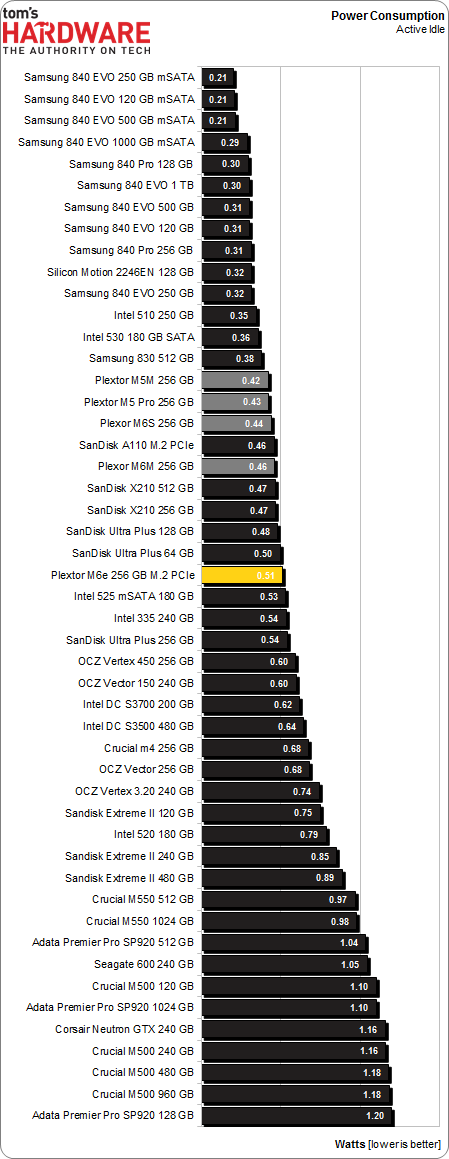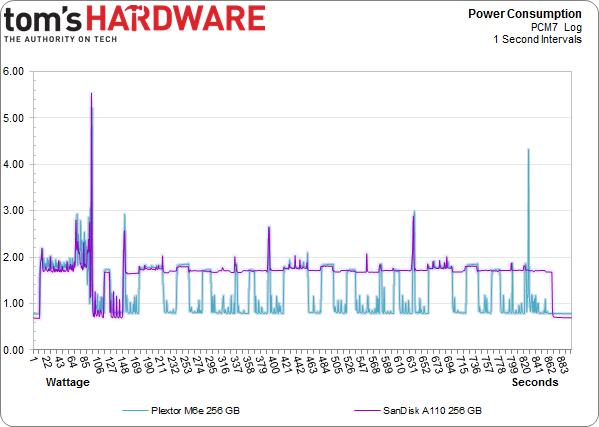Plextor M6e 256 GB PCI Express SSD Review: M.2 For Your Desktop
Plextor's next-gen M6e is a M.2 2280 PCIe SSD combined with a x4 PCIe adapter. You probably don't have a M.2 PCIe slot yet, but Plextor hopes their Marvell 9183 powered SSD will find a home in enthusiast systems thanks to their adapter.
Results: Power Consumption
Active Idle Power Consumption
Idle consumption is the most important power metric for consumer and client SSDs. After all, solid-state drives complete host commands quickly and then drop back down to idle. Aside from the occasional background garbage collection, a modern SSD spends most of its life doing very little. Enterprise-oriented drives are more frequently used at full tilt, making their idle power numbers less relevant. But this just isn't the case on the desktop, where the demands of client and consumer computing leave most SSDs sitting on their hands for long stretches of time.
Active idle power numbers are critical, especially when it comes to their impact on mobile platforms. Idle means different things on different systems, though. Pretty much every drive we're testing is capable of one or more low-power states, up to and including DevSlp. That last feature is a part of the SATA 3.2 host specification. And while it requires a capable SSD and a compatible platform, enabling DevSlp takes power consumption down to a very small number.
Measuring the power use of a SATA-based drive is fairly straightforward; you tap into the 5 or 12 V rail, do some multimeter work, and a bit of math. A PCI Express SSD is more difficult to get readings from. You can either use a riser card, like Igor does in our graphics card reviews, or employ a special purpose-built device.
I do the latter. Active idle is reported as a rule, so I disable the bus' sleep states to yield an equivalent to my SATA storage testing. Yes, the two PCIe-based drives can drop to lower idle power when the slot falls into a low-power condition. But we're concerning ourselves with active results in order to make the right comparison.
There is a trio of states to watch out for:
- L0 is active power/active use
- L0s is active power/idle state
- L1 is low power/slumber state
Plextor claims a .58 W idle specification, and that's pretty darned close to what we observe in PCMark 7.
Get Tom's Hardware's best news and in-depth reviews, straight to your inbox.
PCMark 7 Average Power Consumption
If we log power consumption through a workload, even a relatively heavy one, we see that average use is still pretty close to the idle numbers. Maximum power may spike fiercely, but the draw during a PCMark 7 run is light. You can see the drives fall back down to the idle "floor" between peaks of varying intensity.
The M6e uses less power than SanDisk's A110 through PCMark 7. It also checks in just under Plextor's M6S and M6M.
After quite a bit of power testing, logging, and fiddling with Excel, we end up with the above chart.
SanDisk doesn't specify its idle consumption in the A110's documentation, though Plextor does. But it looks like both SSDs sit idle around the half-watt mark. The A110 does spent a lot more time above idle than Plextor's M6e, and after some discussion with Plextor, it appears there are ways to bring that figure down even more in certain scenarios. But PCIe power management is an entirely different beast, and I continue refining the testing.
Current page: Results: Power Consumption
Prev Page Results: Tom's Hardware Storage Bench v1.0, Continued Next Page Results: TRIM Testing With ULINK's DriveMaster 2012-
dgingeri Someone needs to build an adapter that connects to a PCIe x8 slot and has mounting points for up to 4 or 8 PCIe M2 SSDs.Reply -
Au_equus lots of empty space on that PCB and its only a half height card. Maybe its possible we can see multiple TB PCIs SSDs in the consumer space or they may just restrict it to enterprise.Reply -
Amdlova 300 dollar for 256 gb... i can buy 4x 120gb v300 kingston (2200mb/s R) (1920mb/s W)Reply
raid 0. too expensive. that plextor -
menetlaus Who keeps telling you there is no demand for M.2 drives?Reply
I bought a Lenovo Y410P shortly after they were released (and was incorrectly told it had mSATA not NGFF/M.2 for the SSD), and have been waiting over a year for a decent M.2 drive to put in it. -
swordrage May be in a few years we will see an ssd connected to a PCIe x16 the and size of a graphics card.Reply -
nekromobo How much does it add to boot-time with its bios loading stuff? Other PCI-e cards add as long as a 1-2 minutes to boot time.Reply -
dgingeri It's only a single AHCI device, and it doesn't have to wait for spinup like other raid controllers, so likely only a second or so extra init time.Reply -
cryan Reply13209105 said:lots of empty space on that PCB and its only a half height card. Maybe its possible we can see multiple TB PCIs SSDs in the consumer space or they may just restrict it to enterprise.
The drive itself has no wasted space. The bridge board has plenty, being that the drive is only 22mm x 80mm.
Regards,
Christopher Ryan
-
cryan Reply13209786 said:How much does it add to boot-time with its bios loading stuff? Other PCI-e cards add as long as a 1-2 minutes to boot time.
It adds all of about a second. You'll never notice, and based on UEFI settings, you might never even see the Plextor op-rom splash screen at post.
Regards,
Christopher Ryan


